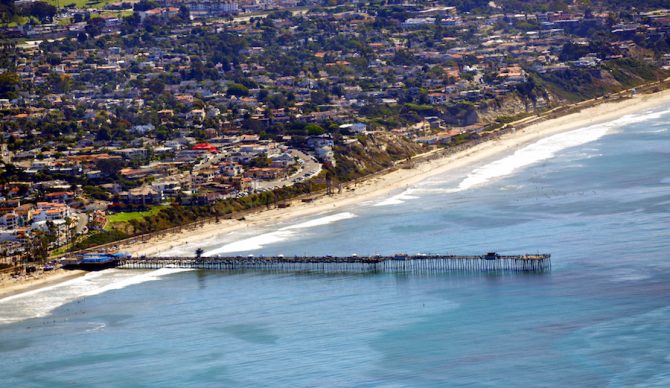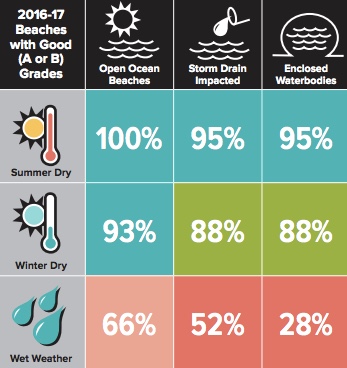
San Clemente Pier is the second most polluted beach in California, according to a new report from Heal the Bay. Photo: Wikimedia Commons
Blame the rain. In Heal the Bay’s newly released annual report card tracking water quality at California beaches, the same wet weather that effectively rescued much of the state from the throes of the drought has resulted in poor water quality in many coastal areas.
Along with rating 416 beaches along the California coast with a straightforward A to F grade (check here to see how your local beach scored), the report calls out ten of the most polluted beaches on what it calls its “Beach Bummers” list.
Some beaches on the list are hardly surprising – Cowell’s Beach has held the no. 1 or 2 spot since 2010, so no. 3 is a mild improvement. Two Southern California beaches, though, are making their debut on the list (San Clemente Pier, and La Jolla Cove), San Clemente Pier coming in at the second most polluted beach in the state.
The 10 “Beach Bummers” are as follows:
1. Clam Beach County Park, McKinleyville (Humboldt County)
2. San Clemente Pier, San Clemente (Orange County)
3. Cowell’s Beach, Santa Cruz (Santa Cruz County)
4. Lakeshore Park, San Mateo (San Mateo County)
5. La Jolla Cove, La Jolla (San Diego County)
6. Santa Monica Pier, Santa Monica (Los Angeles County)
7. Capitola Beach, Capitola (Santa Cruz County)
8. Luffenholtz Beach, Trinidad (Humboldt County)
9. Mother’s Beach, Marina del Rey (Los Angeles County)
10. Monarch Beach, Dana Point (Orange County)
Heal the Bay rates numbers 1-4 on the list as F’s and 5-10 as D’s. Other beaches of concern include Newport Bay in Orange County, Long Beach, Arroyo Burro Beach in Santa Barbara, Linda Mar Beach in Pacifica, and Keller Beach in Richmond.

The report also divides California’s beach grades into types of beaches and season to determine if differences exist in water quality when controlling for these variables. “Open ocean” beaches during dry summer weather consistently earned the best grades (100% earned A’s), while enclosed water bodies during wet weather consistently had the poorest water quality (only 28% earned A’s) – seems to fit with prevailing logic.
But what are local activists and environmental groups doing with this information, and how are they seeking to improve the water quality of beaches across the state? According to Surfrider Foundation’s Water Quality Manager, Mara Dias, the organization’s approach is two-pronged. Across the country, volunteers participate in the Blue Water Task Force program, measuring water quality and sharing information with their community. And to minimize the impacts of urban runoff, Surfrider’s Ocean Friendly Gardens program encourages individuals and communities to contour landscapes to retain water to filter pollution. Local Surfrider chapters have been integral in promoting policy changes to create ocean-friendly landscapes in new developments, and retrofit existing ones.
Dias explains that while Cowell’s is a repeat offender on the list, an active and engaged local chapter in Santa Cruz has made significant progress isolating the causes of pollution. Surfrider is hopeful that by next year Cowell’s will show significant improvement.
For the full report including details on the “Beach Bummers” click here. And to learn more about Surfrider’s efforts to improve water quality or to get involved check out their website.

